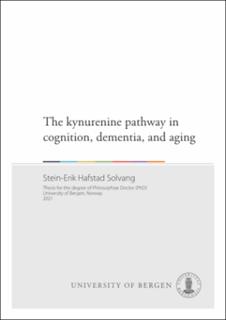| dc.contributor.author | Solvang, Stein-Erik Hafstad | |
| dc.date.accessioned | 2021-06-10T14:40:20Z | |
| dc.date.available | 2021-06-10T14:40:20Z | |
| dc.date.issued | 2021-06-16 | |
| dc.date.submitted | 2021-06-02T07:32:16.405Z | |
| dc.identifier | container/83/f3/19/78/83f31978-a33c-4ef7-ae90-9139682545cc | |
| dc.identifier.isbn | 9788230844946 | |
| dc.identifier.isbn | 9788230846278 | |
| dc.identifier.uri | https://hdl.handle.net/11250/2758889 | |
| dc.description.abstract | Background: Experimental studies implicate the kynurenine pathway in cognitive function, dementia, aging, and longevity. Comparatively, clinical studies are few and most lack comprehensive targeted metabolomic profiling of the kynurenine pathway.
Aims: To investigate associations between circulating kynurenines and cognitive function in older adults (Study I) and between kynurenines, cognitive and neuropsychiatric prognosis in mild dementia (Study II). Lastly, to assess the relationship between aging and concentrations of metabolites of the kynurenine pathway in blood and cerebrospinal fluid (CSF) using longitudinal cohorts (Study III).
Methods: Tryptophan (Trp) and nine kynurenines were measured in serum, plasma and cerebrospinal fluid. Associations between the kynurenines and cognitive performance were estimated using Zellner’s regression in community-dwelling older adults (Study I, n = 2174), and between the kynurenines, cognitive performance and neuropsychiatric symptoms in patients with mild dementia using a multilevel model (Study II, n = 155). In Study III, associations between age and the kynurenines were investigated in multilevel models in two longitudinal studies (n = 970 and n = 604), and non-parametrically in a small cohort with CSF samples (n = 109). Associations between the kynurenines and frailty were assessed using regression, mortality using Cox regression, and minor age differences using a multinomial logit model. The results of studies I and II were adjusted for multiple comparisons.
Main findings: Higher kynurenine to tryptophan ratio (KTR) and neopterin concentrations were linearly associated with lower cognitive test performance, whereas kynurenine (Kyn) had a non-linear, quadratic association with cognitive test performance (Study I). The quadratic association between cognitive test performance and Kyn was also present in mild dementia, where higher kynurenic acid to kynurenine ratio (KKR) was further associated with more neuropsychiatric symptoms over time (Study II). In Study III, the strongest associations between age and the kynurenines were with Kyn, quinolinic acid (QA), and KTR which were positively associated with age and increased the most over time. Trp was inversely associated with age and decreased over time. Kyn, 3-hydroxykynurenine, kynurenic acid, 3-hydroxyanthranilic acid, QA and KTR were associated with frailty. Higher Trp concentrations were associated with lower all-cause mortality, whereas higher QA and KTR concentrations were associated with higher all-cause mortality in two cohorts of community-dwelling adults. Kyn and QA increased in the CSF over a period of four years and correlated the most with age. Compared to serum concentrations, age was more strongly correlated to CSF concentrations of Kyn and particularly QA.
Conclusions: We found a non-linear relationship between Kyn and cognitive performance in both community-dwelling older adults and patients with mild dementia, where higher and lower Kyn concentrations were associated with poorer cognitive performance. Further, it appears that activation of the kynurenine pathway, reflected by increased KTR, is associated with poorer cognitive performance, aging, frailty, and mortality. However, of the downstream kynurenines, QA showed the strongest association with aging, frailty, and mortality and was more strongly correlated with age in the CSF relative to serum over time. Accordingly, the aging brain could be exposed to a disproportionate increase in the excitotoxic QA. Higher KKR, which may reflect increased kynurenine aminotransferase activity, was associated with more neuropsychiatric symptoms over time. | en_US |
| dc.language.iso | eng | en_US |
| dc.publisher | The University of Bergen | en_US |
| dc.relation.haspart | Paper I: Solvang SH, Nordrehaug JE, Tell GS, Nygård O, McCann A, Ueland PM, Midttun Ø, Meyer K, Vedeler CA, Aarsland D, Refsum H, Smith AD, Giil LM. The kynurenine pathway and cognitive performance in community-dwelling older adults. The Hordaland Health Study. Brain Behav Immun. 2019 Jan;75:155-162. The article is available in the thesis file. The article is also available at: <a href=" https://doi.org/10.1016/j.bbi.2018.10.003" target="blank">https://doi.org/10.1016/j.bbi.2018.10.003</a> | en_US |
| dc.relation.haspart | Paper II: Solvang SH, Nordrehaug JE, Aarsland D, Lange J, Ueland PM, McCann A, Midttun Ø, Tell GS, Giil LM. Kynurenines, Neuropsychiatric Symptoms, and Cognitive Prognosis in Patients with Mild Dementia. Int J Tryptophan Res. 2019 Sep 29;12:1178646919877883. The article is available at: <a href=" https://hdl.handle.net/11250/2726666" target="blank">https://hdl.handle.net/11250/2726666</a> | en_US |
| dc.relation.haspart | Paper III: Solvang SH, Hodge A, Watne LO, Cabral-Marques O, Nordrehaug JE, Giles GG, Milne RL, Dugué PA, Nygård O, Ueland PM, McCann A, Idland AV, Midttun Ø, Ulvik A, Tell GS, Giil LM. Kynurenine pathway metabolites in the blood and cerebrospinal fluid are associated with human aging. The article is not available in BORA. | en_US |
| dc.rights | In copyright | |
| dc.rights.uri | http://rightsstatements.org/page/InC/1.0/ | |
| dc.title | The kynurenine pathway in cognition, dementia, and aging | en_US |
| dc.type | Doctoral thesis | en_US |
| dc.date.updated | 2021-06-02T07:32:16.405Z | |
| dc.rights.holder | Copyright the Author. All rights reserved | en_US |
| dc.description.degree | Doktorgradsavhandling | |
| fs.unitcode | 13-25-0 | |
